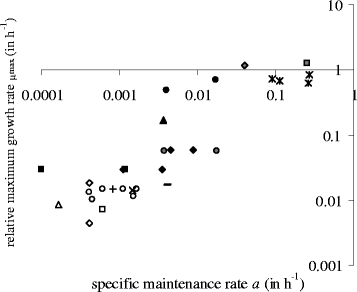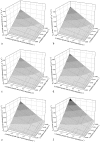Microbial maintenance: a critical review on its quantification
- PMID: 17333428
- PMCID: PMC1915598
- DOI: 10.1007/s00248-006-9049-5
Microbial maintenance: a critical review on its quantification
Abstract
Microbial maintenance is an important concept in microbiology. Its quantification, however, is a subject of continuous debate, which seems to be caused by (1) its definition, which includes nongrowth components other than maintenance; (2) the existence of partly overlapping concepts; (3) the evolution of variables as constants; and (4) the neglect of cell death in microbial dynamics. The two historically most important parameters describing maintenance, the specific maintenance rate and the maintenance coefficient, are based on partly different nongrowth components. There is thus no constant relation between these parameters and previous equations on this subject are wrong. In addition, the partial overlap between these parameters does not allow the use of a simple combination of these parameters. This also applies for combinations of a threshold concentration with one of the other estimates of maintenance. Maintenance estimates should ideally explicitly describe each nongrowth component. A conceptual model is introduced that describes their relative importance and reconciles the various concepts and definitions. The sensitivity of maintenance on underlying components was analyzed and indicated that overall maintenance depends nonlinearly on relative death rates, relative growth rates, growth yield, and endogenous metabolism. This quantitative sensitivity analysis explains the felt need to develop growth-dependent adaptations of existing maintenance parameters, and indicates the importance of distinguishing the various nongrowth components. Future experiments should verify the sensitivity of maintenance components under cellular and environmental conditions.
Figures

 [10]; × [21];○ [22];
[10]; × [21];○ [22];  [23]; — [26];
[23]; — [26];  [29];
[29];  [33];
[33];  [34];
[34];  [36];
[36];  [43];
[43];  [44];
[44];  [58];
[58];  [59]; + [60]).
[59]; + [60]).


References
-
- {'text': '', 'ref_index': 1, 'ids': [{'type': 'DOI', 'value': '10.1016/S1369-703X(01)00148-6', 'is_inner': False, 'url': 'https://doi.org/10.1016/s1369-703x(01)00148-6'}]}
- Amrane, A (2002) Unstructured model for the decline phase of batch cultures of Lactobacillus helveticus growing on supplemented whey permeate. Biochem Eng J 10: 9–15
-
- {'text': '', 'ref_index': 1, 'ids': [{'type': 'PubMed', 'value': '13687855', 'is_inner': True, 'url': 'https://pubmed.ncbi.nlm.nih.gov/13687855/'}]}
- Bauchop, T, Elsden, SR (1960) The growth of microorganisms in relation to their energy supply. J Gen Microbiol 23: 457–469 - PubMed
-
- {'text': '', 'ref_index': 1, 'ids': [{'type': 'DOI', 'value': '10.1111/j.1574-6968.1990.tb03942.x', 'is_inner': False, 'url': 'https://doi.org/10.1111/j.1574-6968.1990.tb03942.x'}]}
- Beeftink, HH, van der Heijden, RTJM, Heijnen, JJ (1990) Maintenance requirements: energy supply from simultaneous endogenous respiration and substrate consumption. FEMS Microbiol Ecol 73: 203–210
-
- {'text': '', 'ref_index': 1, 'ids': [{'type': 'DOI', 'value': '10.1007/BF00251851', 'is_inner': False, 'url': 'https://doi.org/10.1007/bf00251851'}]}
- Beyeler, W, Rogers, PL, Fiechter, A (1984) A simple technique for the direct determination of maintenance energy coefficient: an example with Zymomonas mobilis. Appl Microbiol Biotechnol 19: 277–280
-
- {'text': '', 'ref_index': 1, 'ids': [{'type': 'DOI', 'value': '10.1016/S0038-0717(98)00028-5', 'is_inner': False, 'url': 'https://doi.org/10.1016/s0038-0717(98)00028-5'}]}
- Blagodatsky, SA, Richter, O (1998) Microbial growth in soil and nitrogen turnover: a theoretical model considering the activity state of microorganisms. Soil Biol Biochem 30: 1743–1755
Publication types
MeSH terms
LinkOut - more resources
Full Text Sources

